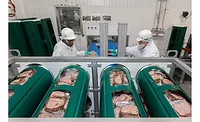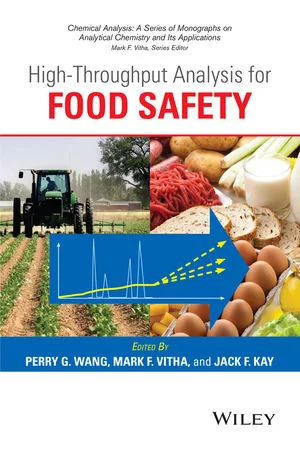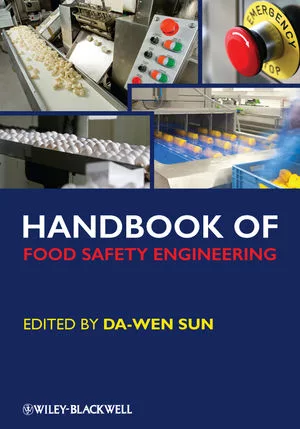Better Under Pressure: How to Take Advantage of High-Pressure Processing
High-pressure processing (HPP) is rapidly becoming a mainstream method for treating food products. HPP is a post-package intervention that represents a change in delivering safer food. With advances in equipment and the availability of toll processors, this technology has become a cost-effective way to address food safety and protect the brand equity of manufacturers.
 Additionally, HPP dramatically extends the shelf life of many products, which allows manufacturers to migrate products from frozen to fresh. It also provides an opportunity to offer “clean labels” by reformulating many products to eliminate preservatives. Both of these benefits have become major trends within the food industry.
Additionally, HPP dramatically extends the shelf life of many products, which allows manufacturers to migrate products from frozen to fresh. It also provides an opportunity to offer “clean labels” by reformulating many products to eliminate preservatives. Both of these benefits have become major trends within the food industry.
While the benefits of HPP make it a viable option for manufacturers, its implementation requires extensive planning and testing to achieve desired results.
Understanding the Process
The threshold step for implementation is to have a clear understanding of what HPP can and cannot do. The process subjects packaged products (with the exception of shellfish, which are processed without packaging) to water pressures of up to 87,000 psi (600) MPa in a large pressure vessel for a specified period of time, usually lasting 3 minutes.
 During the process, there is a 15 percent compression, but because the pressure is hydrostatic, there is generally no impact on the product’s taste or texture. There also is an adiabatic increase in temperature of approximately 30 degrees on most ready-to-eat (RTE) meats. The non-cooking rise in temperature may vary depending on the product formula. Typically, formulas with high fat content or oil will see a greater increase in adiabatic temperature rise.
During the process, there is a 15 percent compression, but because the pressure is hydrostatic, there is generally no impact on the product’s taste or texture. There also is an adiabatic increase in temperature of approximately 30 degrees on most ready-to-eat (RTE) meats. The non-cooking rise in temperature may vary depending on the product formula. Typically, formulas with high fat content or oil will see a greater increase in adiabatic temperature rise.
Upon decompression, the temperature returns to its starting point and generally has no effect on the product. Even at the highest pressure, the increase in adiabatic temperature is extremely lower than thermal processing. At these general parameters, HPP eliminates pathogens, such as Listeria monocytogenes, Escherichia coli and Salmonella, and deactivates spoilage organisms.
However, in order to be effective, there must be at least 15 percent water activity. Therefore, this is not an appropriate process for all products (e.g., spices and peanut butter). If there is too much water activity relative to product structure, it can wilt certain products, such as leafy greens. But, there is a large range of products that can withstand and benefit from HPP, including fresh ground beef and turkey, RTE meats, salsas, hummus, dips and juices.
Requirements for Implementation
After concluding that HPP meets a manufacturer’s requirements for food safety, shelf life or formulation, it’s necessary to conduct a series of essential steps before the process can be successfully implemented.
First, initial testing must be done to determine the organoleptic impact. If this threshold test is met, it’s important to conduct an inoculation study to have the proper documentation and verification for both regulatory and liability purposes. It’s also critical to understand that HPP does not inactivate spores; therefore, products that can develop Clostridium botulinum, such as fresh fish, need to be addressed with additional formulaic solutions. Furthermore, it’s crucial to undergo shelf life studies, considering both food safety and taste and texture performance.
A parallel path also is generally needed to modify packaging so it maximizes vessel loading, but does not fail under pressure. While modified atmosphere packages can withstand HPP, this can double the cost per pound because vessel capacity is being taken up with air and gas.
The next step is regulatory. This intervention needs to be integrated into a Hazard Analysis & Critical Control Points (HACCP) plan. If a toll processor is utilized, the HACCP plans of both the manufacturer and toll processor must to be integrated. Additionally, since HPP is typically a CCP, transfer labels, date coding and other supply chain issues need to be addressed.
Finally, it is important to note that HPP is only a step in the entire food safety process. Results will be best if the manufacturer has already established first-class Sanitation Standard Operating Procedures (SSOP).
Seeking Outside Expertise
While it offers many benefits, HPP presents considerable up-front costs. However, aside from costs, perhaps the biggest challenges surround the skill, expertise and experience required to use that equipment properly.
Given the significant hurdles to implementing HPP, some companies choose to outsource this process. While focusing on their own core competencies, food manufacturers can depend on an experienced toll processor to successfully manage all points of the high-pressure process from start to finish.
Toll companies can take products through the entire process from product or package testing, through implementation and post-inspection to pack-off (including labeling, packing, bar coding and palletizing) and distribution back to the manufacturer, distributor or directly to the end retailer.
Coordinating volume stream also can be a challenge to HPP implementation. Using toll processors that operate multiple processing lines, companies can process large quantities of product at once. Depending on volume, manufacturers can send product weekly, monthly or yearly, with the processor warehousing the excess product until processing occurs.
Overall, HPP offers manufacturers, processors, retailers, distributors and foodservice operators multiple benefits. It dramatically improves food safety and quality, and it protects brand equity with its unique ability to destroy pathogens without altering a food’s taste and texture. HPP also expands opportunities for new product development, helping companies remain competitive and active in responding to consumer demands. Lastly, it helps manufacturers address two significant trends in the food industry—providing clean label products and keeping products fresh.
Justin Segel is the CEO of American Pasteurization Company, the first company to offer HPP on a tolling basis to food manufacturers nationwide, and has more than 36 years of experience in the food industry. Justin can be reached at justin_segel@amerpastco.com.
Looking for quick answers on food safety topics?
Try Ask FSM, our new smart AI search tool.
Ask FSM →








